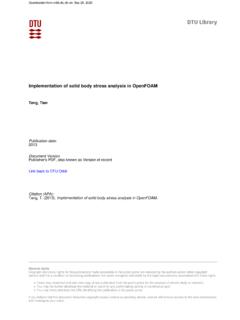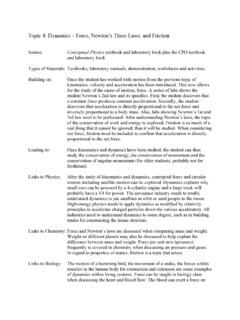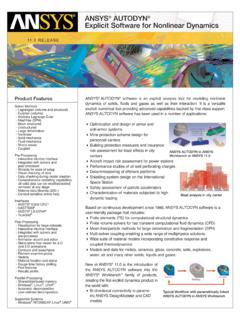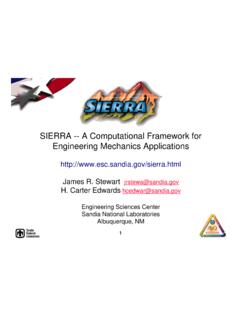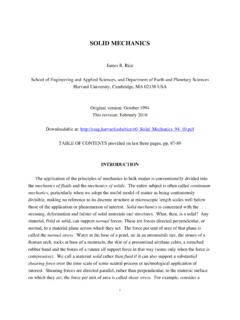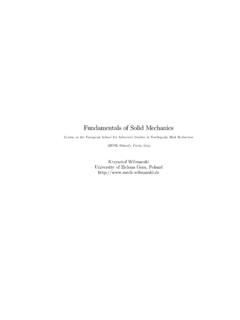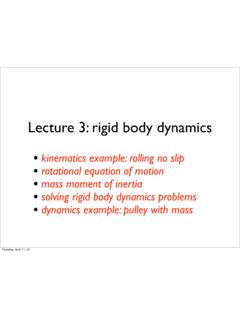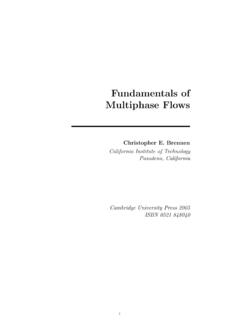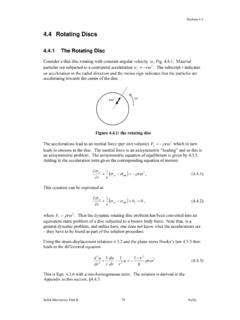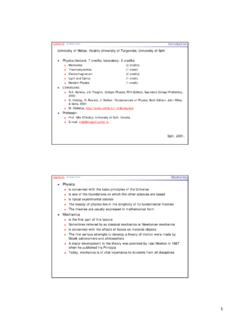Transcription of THEORETICAL - Facultatea de Constructii Civile ...
1 0 PROF . DR. ING. VASILE SZOLGA THEORETICAL mechanics LECTURE NOTES AND SAMPLE PROBLEMS PART ONE STATICS OF THE PARTICLE, OF THE RIGID BODY AND OF THE SYSTEMS OF BODIES KINEMATICS OF THE PARTICLE 2010 1 Contents Chapter 1. 5 The object of the 5 Fundamental notions in THEORETICAL 6 Fundamental principles of the THEORETICAL 7 THEORETICAL models and schemes in 9 STATICS Chapter 2. Systems of 11 11 11 Projection of a force on an axis. Component of the force on the direction of an 13 Addition of two concurrent 14 The force in Cartesian system of 16 The resultant force of a system of concurrent forces. Theorem of 18 Sample 19 Moment of a force about a given 24 Moment of a force about the origin of the Cartesian system of 27 Sample.
2 29 Moment of a force about a given 30 Sample 32 The 35 Varignon s 36 Reduction of a force in a given 37 Reduction of a system of forces in a given 38 Sample 39 Invariants of the systems of forces. Minimum moment, central 41 Cases of 44 Sample .. 47 Varignon s theorem for an arbitrary system of 53 Systems of coplanar 54 Sample 57 2 Systems of parallel forces. Center of the parallel 59 Chapter 3. Centers of 64 64 of 64 66 of gravity for homogeneous bodies, 68 of gravity for composed 69 for simple usual homogeneous 72 77 Pappus Guldin 84 Chapter 4. Statics of the 87 87 Equilibrium of the free 87 Sample 89 Constraints.
3 Axiom of the 91 Equilibrium of the particle with ideal 94 Sample 96 Laws of friction. Equilibrium of the particle with constraints with 98 Sample 100 Chapter 5. Statics of the rigid 103 103 Equilibrium of the free rigid 103 Ideal constraints of the rigid body in plane (in two dimensions).. 109 Statically determined and stable rigid 114 116 Steps to solve the reactions from the constraints of a statically determined and stable rigid 119 Sample 120 3 Chapter 6. Systems of rigid 125 125 Internal 125 Equilibrium 128 Statically determined and stable 131 The method of the equilibrium of the component 134 Sample 135 Structural 141 Method of 144 Sample 144 Mixed 146 Sample 149 Method of the equilibrium of the component 151 Sample 152 Symmetrical systems of rigid 155 Sample 158 Chapter 7.
4 165 165 Simplifying 167 Notations, names, conventions of 170 Statically determination of the 171 Method of 172 Sample 175 Joints with particular 182 Method of 183 Sample 185 KINEMATICS Chapter 8. Kinematics of the 188 188 Position of the particle. 189 4 Velocity and 190 Kinematics of the particle in Cartesian 192 Kinematics of the particle in cylindrical coordinates. Polar 195 Kinematics of the particle in Frenet s 199 5 Chapter 1. Introduction The object of the course mechanics may be defined as that science that describe and develop the conditions of equilibrium or of the motion of the material bodies under the action of the forces.
5 mechanics can be divided in three large parts, function of the studied object: mechanics of the no deformable bodies ( mechanics of the rigid bodies), mechanics of the deformable bodies (strength of the materials, elasticity, building analysis) and fluid mechanics . mechanics of the no deformable bodies, or THEORETICAL mechanics , may be divided in other three parts: statics, kinematics and dynamics . Statics is that part of the THEORETICAL mechanics which studies the transformation of the systems of forces in other simpler systems and of the conditions of equilibrium of the bodies. Kinematics is the part of the THEORETICAL mechanics that deals with the motions of the bodies without to consider their masses and the forces that acts about them, so kinematics studies the motion from geometrical point of view, namely the pure motion.
6 dynamics is the part of the THEORETICAL mechanics which deals with the study of the motion of the bodies considering the masses of them and the forces that acts about them. In all these definitions the bodies are considered rigid bodies that are the no deformable bodies. It is known that the real bodies are deformable under the action of the forces. But these deformations are generally very small and they produce small effects about the conditions of equilibrium and of the motion. mechanics is a science of the nature because it deals with the study of the natural phenomenon. Many consider mechanics as a science joined to the mathematics because it develops its theory based on mathematical proofs. 6 At the other hands, mechanics is not an abstract science or a pure one, it is an applied science.
7 THEORETICAL mechanics studies the simplest form of the motion of the material bodies, namely the mechanical motion. The mechanical motion is defined as that phenomenon in which a body or a part from a body modifies its position with respect to an other body considered as reference system. Fundamental notions in THEORETICAL mechanics THEORETICAL mechanics or Newtonian mechanics uses three fundamental notions: space, time and mass. These three notions are considered independent one with respect to other two. They are named fundamental notions because they may be not expressed using other simpler notions and they will form the reference frame for to study the THEORETICAL mechanics . The notion space is associated with the notion of position.
8 For example the position of a point P may be defined with three lengths measured on three given directions, with respect to a reference point. These three lengths are known under the name of the coordinates of the point P. The notion of space is associated also with the notion of largest of the bodies and the area of them. The space in THEORETICAL mechanics is considered to be the real space in which are produced the natural phenomenon and it is considered with the next proprieties: infinity large, three dimensional, continuous, homogeneous and isotropic. The space defined in this way is the Euclidian space with three dimensions that allows to build the like shapes and to obtain the differential computation.
9 In the definition of a mechanical phenomenon, generally, is not enough to use only the notion of space, namely is not enough to define only the position and the largest of the bodies. Mechanical phenomena have durations and they are produced in any succession. Joined to these notions: duration and succession, THEORETICAL mechanics considers as fundamental notion the time having the following proprieties: infinity large, one-dimensional, continuous, homogeneous and irreversible. The time between two events is named interval of time and the limit among two intervals of time is named instant. 7 The notion of mass is used for to characterize and compare the bodies in the time of the mechanical events.
10 The mass in THEORETICAL mechanics is the measure of the inertia of bodies in translation motion and will represent the quantity of the substance from the body, constant in the time of the studied phenomenon. Besides of these fundamental notions, THEORETICAL mechanics uses other characteristic notions, generally used in each part of the mechanics . These notions will be named as basic notions and they will be defined for each part of mechanics . In Statics we shall use three notions: the force, the moment of the force about a point and the moment of the force about an axis. In Kinematics the basic notions will be: the velocity and the acceleration and in dynamics we shall use : The linear momentum, the angular momentum, the kinetic energy, the work, the potential energy and the mechanical energy.
